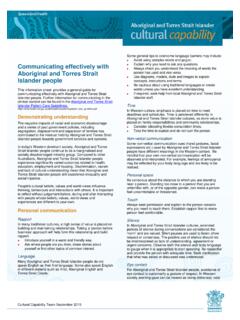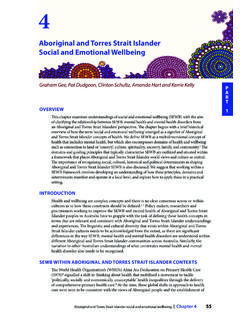Transcription of Aboriginal and/or Torres Strait Islander ‘warning’
1 Gulanga Good Practice Guides These guides provide information on topics that aim to assist organisations implement and embed good practice when working and engaging with Aboriginal and/or Torres Strait Islander peoples, particularly within the ACT and region. Each guide provides a general overview, which we hope will generate change and discussion within a workplace. Links are provided at the end of each guide for further information and research. Feedback on the guides can be directed to or by phone to 02 6202 7200. Aboriginal and/or Torres Strait Islander warning'. Last updated December 2016. For the purpose of this information sheet, communications can include various mediums used for internal and public distribution such as: promotional materials, flyers, posters and products, website content, video and sound recordings, slide presentations, publications, reports and newsletters.
2 Your communications cannot anticipate the passing of an Aboriginal or Torres Strait Islander person. It is important to note that prior to colonisation in 1788, cultural practices around death were strictly followed for many thousands of years. The impact of colonisation has affected these practices on many levels over a short period of time, for example, through the loss of access to land to perform cultural practices, government policies that prohibited cultural practices, and the introduction of technology such as the internet, cameras, film and the written word. In many communities, these cultural practices have had to evolve and adapt. For some Aboriginal peoples, particularly in northern Australia, strict cultural practices prohibit them from seeing an image of a deceased person. This can also include naming the person, written material that includes the name of a deceased person, a display of the deceased person's artwork, and listening to a musical recording of the deceased person.
3 It can cause deep distress and sadness for family members, extended family members, communities and peoples associated with the deceased. As an example, you may have included a photo of an Aboriginal person on your website and that person has passed on recently. As a consequence, you may be asked by the family to take down the image from your website. Cultural beliefs, practices and protocols can be very strict and will vary for each family or community. It is advisable and respectful to consult the family and community for appropriate protocols. In some circumstances, the family or community may grant permission to continue use in your communications. It may not always be practical or appropriate to do so. However, we do recommend you give the inclusion of a warning careful consideration, such as: Aboriginal and/or Torres Strait Islander peoples should be aware that this (publication / website / video etc.)
4 May contain the (images / voices / names) of people who have passed away. Further information and research Australia Council for the Arts: Protocols for Working with Indigenous Artists Australian Government: Cultural Protocols Relating to Death in Indigenous Communities Secretariat of National Aboriginal and Islander Child Care: Sorry Business Gulanga Program | ACT Council of Social Service Inc. | | ACTCOSS is committed to reconciliation, acknowledges the traditional custodians of the land and pays respect to elders past and present. 2.






